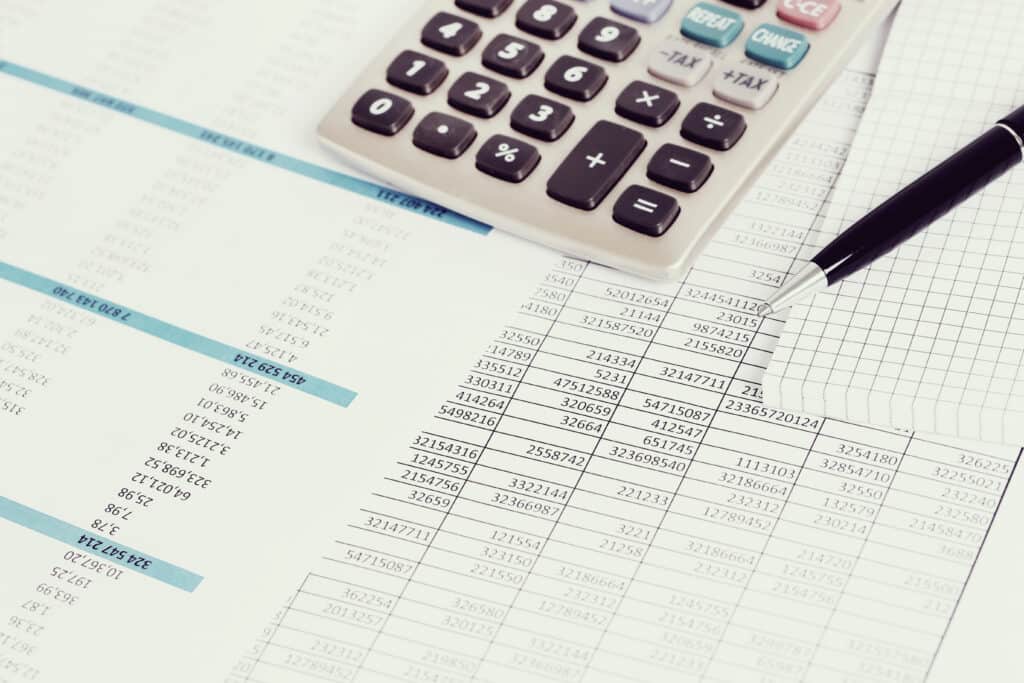Are you wanting to keep track of your budget but don’t know where to start? A budget excel template is a great option to easily track your budget without getting bogged down in all the details of some of the more complicated tools. Whether you are saving for your next vacation or getting a handle on your monthly expenses, using a budget template is a smart way to reach your goals.
What Makes a Good Budget Template?

Everyone starts off budgeting with good intentions, but a budget only works if you stick to it. I’m sure you’ve heard the survey results and personal finance statistics that say only 41% of people follow a budget. One of the essential qualities of a great budget template is that it is easy to use. As an unreformed spreadsheet nerd, I tend to make things more complicated than they need to track and categorize every transaction’s smallest detail. But when it comes time to sit down and actually go over the data, I am reluctant because it will take me.
It’s a myth that budgeting has to take multiple hours every month. Find a template that allows you the flexibility to adjust to fit your budget and lifestyle needs. You’re probably better off tracking only 9 or 10 budget categories rather than 30 or 40. You can always split it out later if you find you need more granularity into a particular line item. With simplicity in mind, what follows are some of my favorite recommended budget templates (in Excel or otherwise).
5 Best Free Budget Excel Templates

Google Docs Budget Spreadsheets
If you have a Google account (and who doesn’t?), you can search the Google Docs template gallery for pre-made budget spreadsheets. There’s a lot to like about keeping your budget in a Google Sheet:
- Easily accessed from anywhere you have an internet connection
- Simple, clean template
- Comes with pre-built budget categories, but you can also customize it to meet your needs
There are currently two different budget templates, one for a monthly budget and one for an annual budget. Both track your income and expenses and give you some pretty charts and graphs of your cash inflow and outflow using pre-set formulas. For me, I’d pick the annual budget, so I would only have to keep track of a single file for the year. But if you want a little more detailed look into your finances, you could go with the monthly option. How to Get the Budget Template: Go to docs.google.com and choose “Sheets.” Then you can browse the template library. Here is the monthly budget and the annual budget.
Federal Trade Commission Budget Worksheet
For ultimate simplicity, the Federal Trade Commission published a 2 page fillable PDF that allows you to input your income and expenses by month. You can also print it out and fill it out by hand if you are more comfortable with that. There are budget categories for housing, food, transportation, health, personal, finance, and others. If you are not an Excel whiz and are just looking for a simple way to track your finances, this could be the budget template for you. How to Get the Budget Template: Go to the FTC website under Managing Your Money, and click on Making a Budget.
Microsoft Excel Budget Templates
If you came here for budget Excel templates, where better to look than Microsoft’s template library? There are dozens of budget spreadsheet templates available to choose from. Microsoft has something for everyone, whether you’re looking for a simple monthly budget tracker or a fancy budget workbook with multiple tabs and graphs. They even have templates for specific events such as weddings, vacations, or college. How to Get the Budget Template: Browse the available budgeting Microsoft templates online and download any interesting ones.
PearBudget Excel Template
PearBudget started as a downloadable Excel template that is now a full-blown online budgeting tool. But the original Excel budget spreadsheet is still available to download for free. You can track your expenses by month, and there are plenty of helpful instructions within the tool to keep you on track. I like PearBudget because it separates your variable expenses like groceries, gas, and medical costs from your regular fixed expenses like rent, insurance, and your phone bill. There is also an Analysis tab to help you compare your income and expenses across months and see where you might be able to save. How to Get the Budget Template: You can download the Excel budget template from the PearBudget website.
Vertex42 Budget Templates
If you haven’t stumbled across Vertex42 before, it is a treasure trove of all things Excel. As of this writing, they have 33 different Excel budget templates to choose from, ranging from basic family budget planners to complex analytics of every transaction. I’m a visual learner, so some of the available templates with graphs and charts help me more easily see my budget position than just looking at numbers on a spreadsheet. How to Get the Budget Template: Browse all available budget templates at Vertex42.
Budgeting Basics

Honestly, you don’t even need a spreadsheet to track your budget. At its most basic, a pen and paper will do. The goal of budgeting is to understand where your money is coming from and where it’s going. From there, you can set your budget limits to try to achieve your goals, whether that be saving for a family vacation or investing more money in your 401k.
Track Your Income
Before you ever make a budget, it’s important to track your inflows and outflows. For most people, tracking income is pretty straightforward. If you get paid biweekly, you will record your paycheck when you receive it. Since there are 26 pay periods in a year, you’d get two paychecks in most months, but in a couple, you’d receive three. If you have any other sources of income, you will want to track those as well. Whether you make a few dollars here and there from apps on your phone, or you learned how to make an extra 1000 dollars a month through side hustles, track it! As the saying goes, “what gets measured gets managed.” By writing down all your sources of income, you may find ways you can increase your various income streams.
Track Your Expenses
On the flip side, you also need to track where your money is going. Tracking your expenses is one of the single best things you can do to create a better financial future for yourself and your family. Most people are shocked where they spend their money when they see it all laid out. Perhaps you thought you were spending $200 a month going out to eat, but really it’s closer to $1,000.
Or the reality of the fact that your mortgage takes up more than 50% of your paycheck becomes clear when you see it on paper. There’s nothing wrong with spending money, but often when you see it on paper, you realize you’re spending more on things you don’t really value and less on things you do. This allows you to do the hard work of redirecting your money to where you want to spend it.
Set a Budget and Stick to It
After you have tracked your income and expenses for a month or two, you are ready to evaluate your financial situation and set a budget seriously. There are many ways to go about budgeting, and different methods work for different people. For some people, you may need to set a budget limit for every spending category and track it diligently to reach your goals. For others, by monitoring your spending, you readily see a few areas you need to keep an eye on, and you just set a budget for certain types of spending. There are no wrong answers, as long as you are working toward achieving your financial goals.
Need Help Setting Budgeting Goals?

It can be overwhelming at first to get started with a budget. How much should you be spending on food, or your mortgage, or clothes? How much should I be saving for retirement or in an emergency fund? If you need a little help setting your initial budget expectations, here are a few tried and true methods to use as guidelines.
Dave Ramsey’s Budget Percentages
Dave Ramsey is arguably the godfather of the household budget. The Dave Ramsey budget percentages are a great tool to get your household budget on track. He assigns a percentage of your spending to each of eleven different budget categories:
- Giving – 10%
- Saving – 10%
- Food – 10 to 15%
- Utilities – 5 to 10%
- Housing – 25%
- Transportation – 10%
- Health – 5 to 10%
- Insurance – 10 to 25%
- Recreation – 5 to 10%
- Personal Spending – 5 to 10%
- Miscellaneous – 5 to 10%
Keep in mind these are only guidelines for creating your own budget. For example, housing may cost more in some areas of the country, or specific health needs may require more spending. But these budget percentages provide a great starting point to get you going.
The 50-20-30 Budget
The 50/20/30 budget is another system similar to Dave Ramsey’s budget percentages, and it’s even simpler. With this budget, 50% of your spending goes toward needs, 30% to wants, and 20% toward savings. In comparison to the budgeting percentages above, it would look something like this:
- 50% Needs – Housing, Utilities, Food (Groceries), Transportation, Insurance
- 30% Wants – Food (Dining Out), Recreation, Personal, Miscellaneous
- 20% Savings – Savings, retirement, debt payment
Reverse Budgeting
Reverse budgeting is just what it sounds like. You “pay yourself first” by determining how much of your income you will save. Only after taking this amount off the top do you then allocate the rest to your expenses. This is a useful exercise if you find yourself scratching your head at the end of every month and wondering why you don’t have anything left to put into savings.
Paycheck to Paycheck Budget
Are you constantly digging through your wallet or purse for spare change to pay for groceries or saying things like, “I need 20 dollars now!”? If so, then your budget may need a little more intensive care and monitoring. If you’re living paycheck to paycheck and can’t figure out how to get out of the hole, the paycheck to paycheck budget can help. The idea is simple – instead of a monthly or annual budget, your budget revolves around your pay cycle. So if you get paid every two weeks, your budget will cover two weeks at a time.
If rent is due a few days after your first paycheck, that will be part of that biweekly budget. If you have a car payment due on the 12th of every month, make sure to factor it in where it needs to go. This budget will help you plan for all of your expenses and which paycheck they will come from. The ultimate goal is to build up some emergency funds so that you can break the paycheck to paycheck cycle and have a little set aside for unexpected expenses.
Budget Excel Template, The Final Word

There are a lot of excellent resources out there to help you track and maintain your budget. But no budget spreadsheet will magically get your budget on track. You have to actually sit down and do the work. As long as you are willing to track your income and expenses and set realistic budgeting goals, any of the tools listed in this article would be a great place to start. So what are you waiting for? Today is the first day of your financial future!
This post originally appeared on Savoteur and has been published with permission.
